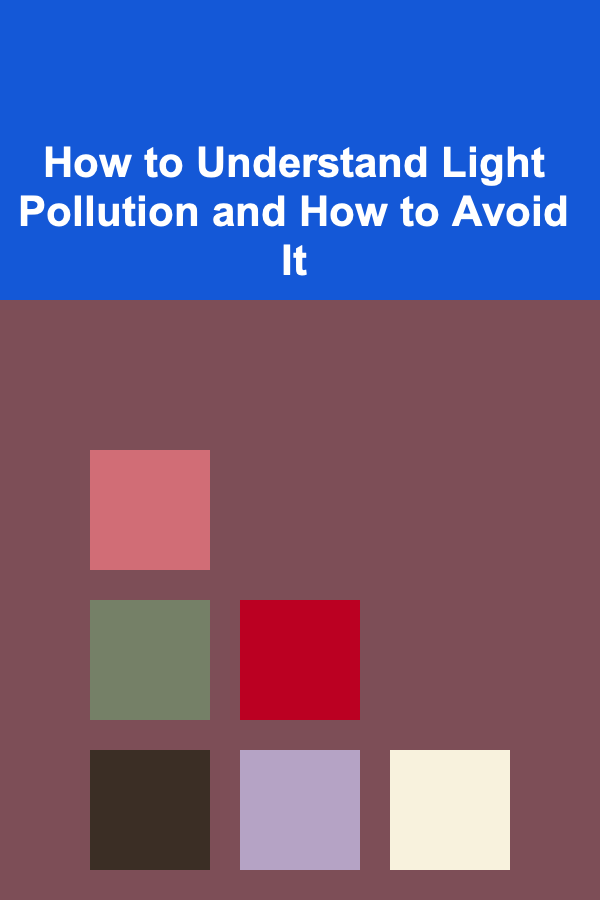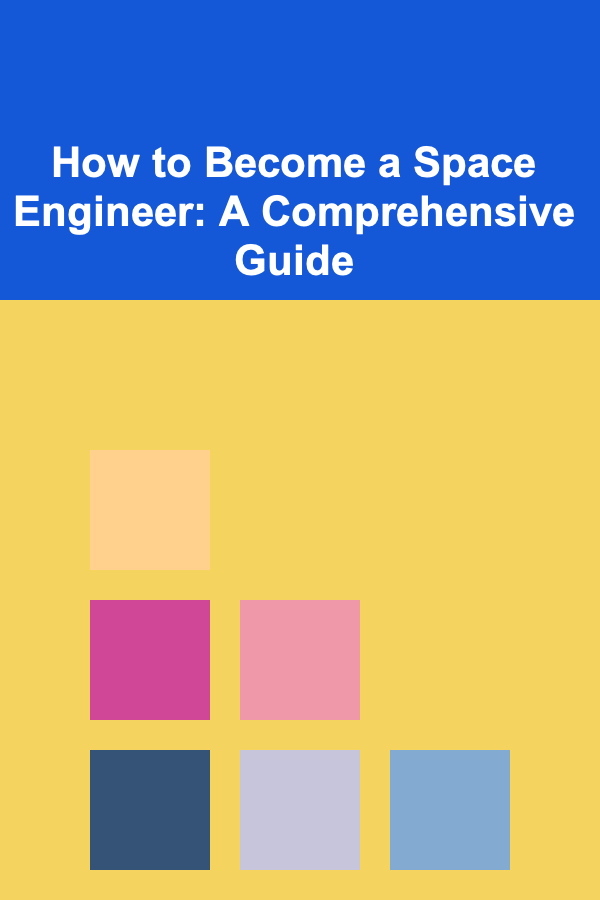
How to Understand Light Pollution and How to Avoid It
ebook include PDF & Audio bundle (Micro Guide)
$12.99$8.99
Limited Time Offer! Order within the next:

Light pollution is a growing issue that affects millions of people around the world. It not only impacts our ability to enjoy the night sky but also has serious implications for human health, the environment, and the natural world. In this article, we will explore what light pollution is, its various types, its effects on human health and ecosystems, and the steps we can take to mitigate its impact. Understanding light pollution is the first step toward minimizing its effects and reclaiming our connection to the night.
What is Light Pollution?
Light pollution refers to the excessive or misdirected artificial light that interferes with the natural darkness of the night sky. It is primarily caused by human activities, especially in urban and suburban areas where artificial lighting is most concentrated. The problem is not just the presence of light itself but how it disrupts the natural environment and our ability to see celestial bodies like stars, planets, and other astronomical phenomena.
While light is essential for modern life, its overuse or improper use leads to several types of light pollution, each with its own set of consequences. These include skyglow, glare, light trespass, and clutter.
Types of Light Pollution
-
Skyglow: Skyglow is the brightening of the night sky over populated areas caused by the scattering of artificial light by air molecules, dust, and water droplets. This effect can be seen as a halo of light above cities, making it difficult for people to see stars and other celestial objects. The farther away you are from a city, the more stars you will be able to see.
-
Glare: Glare occurs when a bright light source causes discomfort and reduces visibility. It is particularly problematic for drivers, as it can create dangerous conditions on the road. Streetlights, headlights, and other artificial lighting sources can cause intense glare if not properly shielded or directed.
-
Light Trespass: Light trespass refers to unwanted light spilling over from one area into another. For example, streetlights that shine into homes or through windows can disrupt sleep and cause discomfort. It is a common issue for people living near urban centers where light spill is prevalent.
-
Clutter: Clutter refers to excessive, poorly designed artificial lighting, often in urban areas, that creates an overabundance of light sources. Neon signs, billboards, and bright streetlights contribute to visual clutter, making the environment uncomfortable and unhealthy for residents.
The Impact of Light Pollution
Human Health
One of the most significant and growing concerns about light pollution is its impact on human health. Our bodies are naturally attuned to the cycle of day and night, and exposure to artificial light at night disrupts this biological rhythm, known as the circadian rhythm.
-
Sleep Disruption: One of the most immediate effects of light pollution is its ability to interfere with sleep. Exposure to artificial light, especially blue light emitted from screens or streetlights, inhibits the production of melatonin, the hormone that helps regulate our sleep-wake cycle. This can lead to insomnia, poor-quality sleep, and an overall disruption of normal sleep patterns.
-
Increased Risk of Chronic Diseases: Persistent exposure to light pollution has been linked to several chronic health issues, including increased risk of obesity, diabetes, cardiovascular diseases, and even cancer. Studies suggest that the suppression of melatonin due to light exposure at night may contribute to the development of these conditions.
-
Mental Health Concerns: The constant presence of artificial light can also contribute to mental health problems, such as anxiety, depression, and stress. A lack of proper sleep, combined with the overstimulation caused by excessive light, can create a cycle of fatigue, irritability, and mood disorders.
-
Disruption of Biological Rhythms: The disruption of circadian rhythms affects not only sleep but also our hormone levels, metabolism, and other bodily processes. For example, shift workers and people who live in light-polluted areas often face disrupted biological rhythms, which can lead to long-term health consequences.
Environmental Impact
Light pollution doesn't just affect human health---it also has far-reaching consequences for the environment and wildlife.
-
Disruption of Animal Behavior: Many species rely on natural light cues for various biological processes. For example, sea turtles use the moonlight to navigate to the sea after hatching, and birds use the stars to migrate. Light pollution can disorient and confuse these animals, causing them to make incorrect decisions, such as heading in the wrong direction or failing to find their habitat.
-
Increased Mortality in Wildlife: Birds, in particular, are at risk from artificial light. Many species are attracted to bright lights at night, leading to fatal collisions with buildings or other structures. This phenomenon, known as "fatal light attraction," is responsible for the death of millions of migratory birds each year.
-
Impact on Plant Life: Plants also rely on the natural cycle of light and darkness. Many plants flower and produce fruit based on the timing of light exposure. Artificial light can disrupt these processes, leading to changes in the timing of flowering, which can negatively affect plant reproduction and the broader ecosystem.
Astronomical Impacts
The most immediate effect of light pollution is on astronomy and our ability to observe celestial objects. With the advent of urbanization, the number of stargazers has significantly decreased. Many people living in cities and towns can no longer see stars, planets, or other astronomical phenomena because of the skyglow caused by artificial lighting.
-
Loss of the Night Sky: Light pollution has led to the gradual disappearance of the natural night sky. The Milky Way, once visible to anyone on a clear night, is now hidden behind a veil of artificial light in many parts of the world. For those who live in urban areas, the sight of a star-filled sky has become a rare experience.
-
Challenges for Astronomical Research: Astronomers rely on dark skies to observe distant stars, planets, and galaxies. Light pollution has made it increasingly difficult for professional and amateur astronomers to conduct research. Observatories located near cities are especially affected, as the lights from nearby areas interfere with telescopes' ability to capture clear images of distant objects.
How to Avoid and Mitigate Light Pollution
1. Use Energy-Efficient and Properly Shielded Lighting
One of the most effective ways to reduce light pollution is by using energy-efficient lighting that is also properly shielded. Shielded lights direct the light downward rather than letting it spill in all directions, which helps minimize skyglow and light trespass. LED lights, in particular, are energy-efficient and can be used with shields to reduce light pollution.
2. Turn Off Unnecessary Lights
A simple but effective way to mitigate light pollution is to turn off unnecessary lights when they are not in use. This includes streetlights, porch lights, and interior lights. Municipalities and homeowners can help by adopting "dark sky" policies, which advocate for the use of dim or motion-activated lighting in outdoor areas.
3. Use Warm-Color Lights
The type of light used also matters. Cooler colors, especially blue light, are more disruptive to the circadian rhythm and contribute more to light pollution. Warm-colored lights, on the other hand, have a less disruptive impact on both humans and wildlife. By replacing cool, white lights with warmer tones, we can reduce the impact on our health and the environment.
4. Advocate for "Dark Sky" Areas
Another effective way to combat light pollution is by advocating for the creation of "dark sky" areas, which are designated spaces free from artificial light. These areas are protected from light pollution and serve as sanctuaries for stargazers and wildlife alike. Many national parks and observatories now promote dark sky initiatives, where people can enjoy the beauty of the night sky without interference from artificial lights.
5. Use Curtains or Blinds
If you live in an area with a lot of light trespass, installing curtains or blinds can help block out unwanted light at night. This simple step can improve the quality of your sleep and reduce the impact of light pollution on your health.
6. Educate the Public
Public awareness is key in the fight against light pollution. By educating communities about the effects of light pollution and the simple steps they can take to reduce it, we can encourage more people to take action. Initiatives such as Earth Hour, where individuals and businesses turn off lights for one hour to raise awareness of light pollution, can have a significant impact on public attitudes toward the issue.
7. Support Legislation and Policy Change
Governments and municipalities play a vital role in reducing light pollution. Supporting policies that regulate the use of outdoor lighting and encourage energy-efficient and shielded lighting can help curb the effects of light pollution on a larger scale. Local authorities can also establish ordinances that restrict light pollution in certain areas, such as near observatories, nature reserves, or parks.
Conclusion
Light pollution is a growing issue that affects more than just our ability to see the stars. Its impact on human health, wildlife, and the environment is profound, and it is something that must be addressed if we hope to preserve the natural beauty of the night sky and improve the quality of life for future generations. By understanding light pollution and taking proactive steps to reduce it, we can make a significant difference in the fight to reclaim the night. Whether through individual actions or collective efforts, we all have a role to play in mitigating light pollution and ensuring a healthier, more sustainable future.

How to Involve Kids in Seasonal Organization Projects
Read More
How to Keep Project Instructions and Ideas Organized
Read More
How to Sell Vintage Video Games on eBay: A Comprehensive Guide
Read More
How to Utilize Vertical Space for Storing Pet Items
Read More
How to Become a Space Engineer: A Comprehensive Guide
Read More
Creating Engaging and Effective Educational Online Courses
Read MoreOther Products

How to Involve Kids in Seasonal Organization Projects
Read More
How to Keep Project Instructions and Ideas Organized
Read More
How to Sell Vintage Video Games on eBay: A Comprehensive Guide
Read More
How to Utilize Vertical Space for Storing Pet Items
Read More
How to Become a Space Engineer: A Comprehensive Guide
Read More